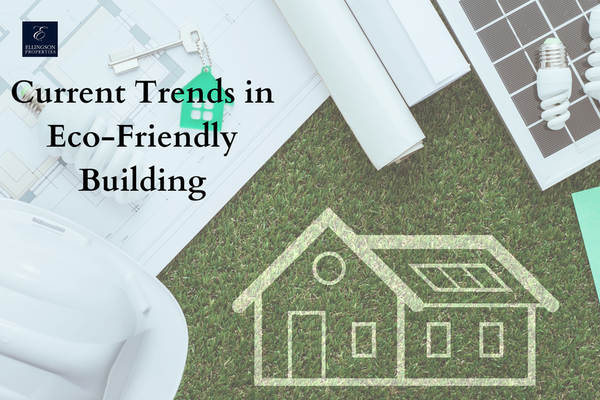Current Trends in Eco-Friendly Building: 2023 Edition
Posted: June 21st, 2023
Green Building Practices are Becoming a Priority
The idea of green building is relatively new, appearing in earnest in the United States for the first time in the 1970s and experiencing a resurgence in the 1990s thanks to the Greening the White House initiative. While many perceived green building as a novelty when it first arrived on the scene, it has rapidly become apparent just how beneficial it can be.
For contemporary construction projects, eco-friendly building is quickly becoming a priority–especially here in Central Florida, where the health of our communities is significantly affected by the health of the environment surrounding us.
Today’s homebuyer understands that following eco-friendly construction practices is not only beneficial for the environment, but also for their pocketbook! Often, green structures and appliances can help homeowners save money on electricity and utility costs while reducing maintenance costs. Building green is a win for just about everyone, so it makes sense that architects and construction professionals would seek new technologies and techniques to meet a continually rising demand.
How Have Green Building Trends Changed Over the Years?
It has been a decade since we last wrote about the green building trends promoted by the U.S. Green Building Council, and it’s interesting to note which of their predictions came true. Perhaps most notably, in 2013, the Green Building Council predicted that smartphones would play a crucial role in green technology, giving homeowners the ability to monitor the energy consumption of appliances and fixtures through the use of apps.
Since 2013, attitudes toward eco-friendliness and sustainability have become less novel and more essential. As green building technology has continued to develop at breathtaking speeds, architects and construction professionals have dialed in on the techniques that make a real difference for homeowners, businesses, and the environment. The result: homes and communities that create less waste during construction and beyond, designed with residents’ health and well-being in mind.
Current Focuses in Green Building
Leaders in green building are focusing on a handful of core principles for the good of the environment and all who inhabit it.
Passive Design
One of the most-cited trends in green building is passive design, which utilizes the local climate and the surrounding environment to reduce energy consumption. For example, many builders will angle a home on a lot in such a way that it maximizes the natural light that enters the house to reduce the need for electric lighting. Good passive design can also help prevent excess heat gain from the sun, create healthier indoor air by controlling moisture, and reduce water consumption.
Here in Central Florida, where we can have fairly extreme weather conditions during the summer, the abilities to reduce our cooling costs and manage ambient moisture are indispensable. Not only do they help reduce our carbon footprint, but they also help us save significant amounts of money on utilities.
Sustainable Materials
The word “sustainability” is used frequently in discussions about eco-friendliness, but it’s rarely explained. In a nutshell, a sustainable material is one that doesn’t deplete non-renewable materials or put unnecessary stress on the environment through its harvesting and refining processes. Bamboo is one of the most recognizable sustainable materials; used for flooring, cabinetry, and beyond, bamboo is easy to grow without needing to be replanted and is a surprisingly durable material.
Many green-focused builders also use recycled materials, including wood and metal, to help reduce their impact on the environment and also reduce the waste produced at demolition sites. Plastic is notoriously prolific and difficult to recycle. However, some modern construction and design companies are helping reduce its impact by reforming single-use plastic into building materials that are comparable to traditional methods.
Net-Zero Building
More applicable to large commercial buildings than residential dwellings, the concept of net-zero building has evolved over time. While it initially only accounted for the energy used post-construction, it now also accounts for the energy used during the construction process. While this may seem like a tall order for now, every day we come closer to a net-zero reality.
There are currently very few buildings that can be truly considered net-zero, but researchers and designers continue to perfect techniques with the goal of making such principles widely available to the public. In the not-so-distant future, we may start to see more net-zero homes arriving on the Brevard County housing market.
Focusing on Human Health
During the lockdown phase of the 2020 pandemic, it became clear just how much our homes and regular surroundings affect our overall health. In particular, the importance of good indoor air quality and access to natural sunlight became a primary focus for home design experts.
Human health and green building practices go hand-in-hand. When architects design buildings that utilize readily available natural resources to improve the indoor environment, they also reduce the impact that homes and other dwellings have on our ecosystems. For example, utilizing passive design to maximize the availability of natural light and reduce the need for electric lighting also satisfies our human need to take in natural light on a daily basis. The use of healthy and sustainable building materials has also been shown to improve our indoor surroundings.
What’s Next for Green Building?
We anticipate that our next revisitation of green building trends in 10 years will reveal even more readily available technologies and techniques that will allow all of us to live in comfortable surroundings with minimal impact. For now, the importance of green design and construction practices only continues to grow. Industry leaders understand the importance of protecting our environment and the urgency with which we need to act to preserve natural resources.
Our sister company, Echelon Builders, is dedicated to providing clients with eco-friendly homes at affordable prices. Learn more about their green building techniques, or get in touch with the team by calling 321-339-0320.

